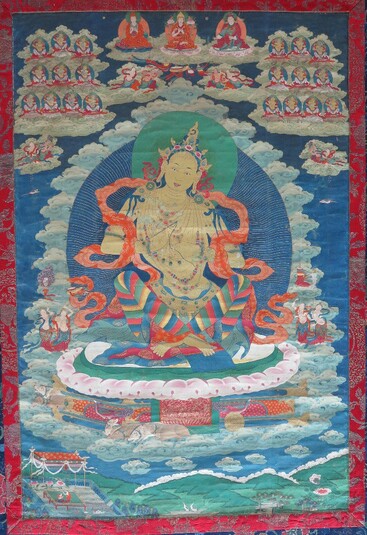
Item: Marichi (Buddhist Deity) - (Holding a Needle & Thread)
| Origin Location | Tibet |
|---|---|
| Date Range | 1700 - 1799 |
| Lineages | Gelug and Buddhist |
| Material | Ground Mineral Pigment on Cotton |
| Collection | Private |
Classification: Deity
Appearance: Peaceful
Gender: Female
Marichi, 'Goddess of the Dawn' holding a needle and thread. This composition is attributed to the artist Trehor Namkha Gyan from the Kham region of Eastern Tibet. The specific iconography of the central figure is based on the instructions of Jetari who then taught it to Vajrasana who then passed it on to his student Bari Lotsawa Rinchen Drag (1040-1111). The earliest written instructions are based on the explanations of Bari Lotsawa.
Marichi is in the appearance of a female goddess, sixteen years of age, youthful and beautiful. She has one face and two arms, yellow in colour. In the right hand she holds a needle and in the left a long strand of thread. She is adorned with various jewels and ornaments, silk scarves and a multi-coloured skirt. In a crouching posture she sits atop a flat moon disc and pink lotus blossom above a large peacock supported chariot shaped throne pulled by seven sows. With a body nimbus and halo, blue and green, Marichi is framed by alternating blue and white clouds completely encircling. At the right and left sides are four offering goddesses holding umbrellas and banners.
Marichi is a deity with many different forms. In this appearance, as in most, she has the function of removing obstacles and specifically outer obstacles meaning real external threats and dangers to a persons physical body or mental well being. In the right and left hands she holds a needle and thread. With these she symbolically takes all the gathered obstacles and life's problems and sews them up all together in a bag for disposal. Likewise for those ill intentions, imprecations and curses of harm doers and gossip mongers their lips and eyes are sewn together to put a stop to their harmful actions.
Marichi and her various obstacle removing functions are described in an 11th century text called the Six Dharmas of Vajrasana. The Six Dharmas are different meditation practices that deal with a host of life's problems afflicting a Buddhist practitioner seeking enlightenment in one lifetime. The six deities and the specific obstacles to be cured are: Marichi for outer obstacles, Achala for inner obstacles, Buddha Lochana for health, Lokeshvara to avert untimely death & bad dreams, Meru Shekhara Buddha for life extension and lastly Trisamayavyuha Buddha for the purging of sins. Vajrasana was the name of an 11th century abbot of Nalanda Monastery in the Northern Indian region of Bihar.
At the top center of the composition is Je Tsongkhapa wearing orange monastic robes and a yellow pandita hat. At the left side is the Indian teacher Jowo Atisha with a blue shirt and an orange pandita hat. At the right side is Padmasambhava attired in the multi-coloured garments of a lay person and wearing a lotus hat. Directly below and kneeling on billowing clouds are four goddesses holding banners and umbrellas as offerings to the three revered teachers above.
At the right and left sides of the upper composition there are twenty small figures of Marichi, identical to the large central subject, ten to the right and ten to the left. These additional forms of the goddess are intended to represent emanations which are manifestations of Marichi created out of her principal form and issue outward in all directions to confront all harm doers and sew up their lips, eyes and bodies for disposal. Directly below that on both sides are four additional offering goddesses sprinkling heavenly water and scattering flower petals.
At the bottom left side of the composition there is a small narrative scene depicting a female figure kneeling in front of a Buddha and receiving a blessing. All of this takes place above a platform in the middle of a pond with a large canopy umbrella above.
Iconographic Elements of the Painting: Size, Descending Order & Hierarchy: - Marichi (central image) - Tsongkhapa, Atisha & Padmasambhava (top center) - Twenty figures of Marichi (upper composition) - Six offering goddesses (upper & middle right and left) - Narrative vignette (bottom left) - Iconographic comparables: none located
Artistic Elements of the Composition: - Subject: figurative - Composition Type: Floating Figure - Ground Colour: Multi-coloured - Painting Style: New Menri & Kham-dri mixed - Region: Eastern Tibet - Date: 18th/19th century - Inscriptions: none - Back of Painting: plain - Artist: Trehor Namkha Gyan
Jeff Watt 1-2016
Buddhist Deity: Marichi Main Page
Buddhist Deity: Marichi (Yellow Forms)
Buddhist Deity: Marichi (Masterworks)
Exhibition: Female Form (DM)
Painting Tradition: Kandze Valley & Trehor Namka Gyan
Collection of Dhargye Museum
Buddhist Deity: Marichi Holding a Needle & Thread
Collection of Dhargye Museum (Painting Gallery 1)

